Entries from February 1, 2017 - February 28, 2017
US swap spread echoing cautionary monetary signal
US narrow money trends suggest a moderation of economic growth in the spring / summer – see post from last week. The two-year swap spread has also led economic fluctuations historically and is giving a similar cautionary message.
The swap spread is a component of the Conference Board’s leading credit index, which feeds into its leading economic index. The spread measures the cost of bank funding over and above the level of “safe” market rates. A rise in the spread indicates that the supply of funding has fallen relative to demand, and may be associated with a reduction in credit supply and higher bank lending / deposit rates.
Narrow money is viewed here as being demand-determined and influenced importantly by spending intentions, explaining why it leads the economy. A reduction in credit supply / higher bank interest rates discourage spending, which may partly account for an observed inverse correlation between narrow money trends and the swap spread.
The first chart, reproduced from the earlier post, shows that turning points in six-month real narrow money growth have consistently led those in two-quarter GDP growth in recent years. The second chart shows a similar relationship with the inverted swap spread.
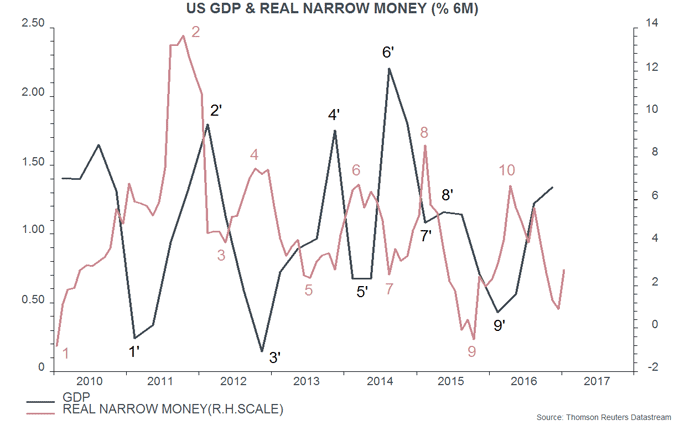
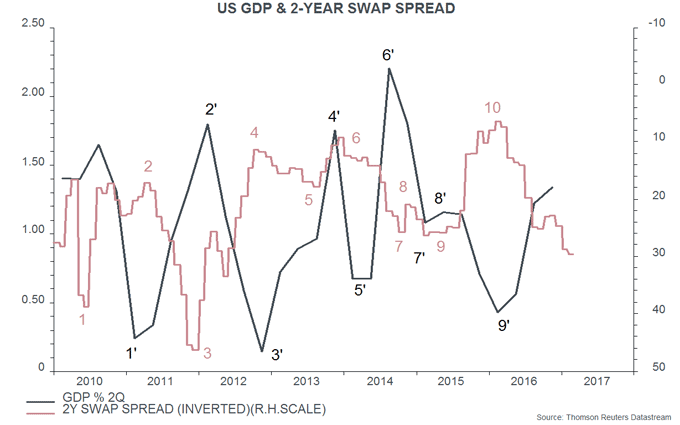
The spread, while still low by historical standards, has widened steadily since early 2016, reaching its highest level since 2012. Why?
One explanation is last year’s reform of money market fund regulations, which resulted in a large movement out of “prime” funds able to invest in a wide range of assets – including bank liabilities – into those limited to government securities. This reduced the supply of bank funding and probably explains a 9% fall in large time deposits at commercial banks during 2016.
The second explanation is that the Federal Reserve has allowed the stock of bank reserves to contract significantly since late 2015, reducing the pool of “excess” reserves available for lending in the funding market. Reserve balances averaged $2.093 trillion in January, down from $2.668 trillion in October 2015 – a 22% drop over 15 months.
The fall in reserves does not reflect any reversal of QE: in line with its stated policy, the Fed has been reinvesting principal repayments and its securities portfolio has remained stable – third chart.
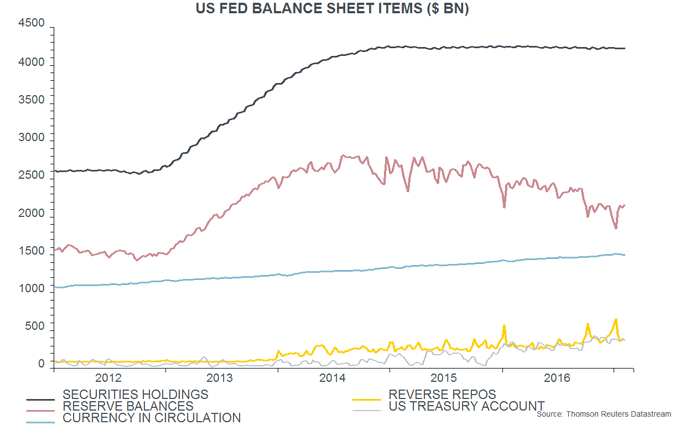
The fall in reserves, instead, has been mainly due to three changes on the liabilities side of the Fed’s balance sheet:
-
“Normal” growth of currency in circulation: banks obtain additional currency for their customers by exchanging reserves with the Fed.
-
A rise in the US Treasury’s deposit balance at the Fed: a higher balance reduces bank reserves, unless offset by Fed market operations.
-
Growth of the Fed’s overnight reverse repo program following a lifting of the $300 billion aggregate cap in December 2015.
The reserves fall, therefore, can be argued to have occurred “naturally” rather than being the result of deliberate Fed policy. The Fed, however, has chosen not to offset the decline despite upward pressure on bank funding costs from the money market fund reform.
Global money trends cooling
Global six-month real narrow money growth fell further in December, suggesting that the world economy will lose momentum during the second half of 2017.
The global narrow money measure tracked here – covering the G7 economies and seven large emerging economies (the “E7”) – has been distorted by India’s “demonetisation” programme, which resulted in a 28% fall in M1 between end-October and end-December, with a recovery now under way. This policy has delivered a short-term shock to the Indian economy but the global implications are limited. An attempt, therefore, has been made to adjust for the distortion by recalculating the global money measure keeping Indian M1 stable at its October level.
Six-month growth of this adjusted measure, deflated by consumer prices, peaked in August 2016 and fell further in December to its lowest level since October 2015. Allowing for an average nine-month lead at turning points, this suggests that global industrial output growth will peak around May and decline through September – see first chart.

The forecasting approach here seeks confirmation of monetary signals from a global leading indicator based on the OECD’s country leading indicators. Six-month growth of this indicator was still rising in November, the latest available month – first chart. The average lead time at historical turning points has been four to five months, so a peak in December or January would be consistent with a May peak in output growth. The OECD will release December data for its indicators tomorrow.
The slowdown in the adjusted global real narrow money measure has been driven by the G7 component and the US in particular – see previous post. Chinese monetary trends remained strong through end-2016, sustaining E7 real money growth, adjusted for the India effect, above the G7 level – second chart. With the PBoC starting to tighten policy – as suggested in a post in December – Chinese narrow money growth may cool but the E7 aggregate may be supported by a reversal of weakness in Brazil / Russia in response to falling inflation / interest rates.

Has the UK's MPC shifted to an unemployment target?
The MPC revised up its growth forecast significantly while making little change to its inflation forecast and retaining a neutral policy stance – contrary to the expectation here of a shift to a tightening bias.
How was the MPC able to raise forecast GDP growth over 2017-2019 by 0.8 percentage points without lifting its longer-term inflation numbers? Mainly by raising its estimate of labour market slack: the “equilibrium” unemployment rate is now judged to be 4.5%, down from 5% in November. The MPC claims that lower-than-expected wage growth over 2014-16 warrants this change of view. Recent wage news, however, has surprised to the upside – annual earnings growth is estimated to have been 2.75% in the fourth quarter of 2016, up from a projected 2.5% in November. Why is the MPC changing its assessment now, rather than three months ago, or earlier?
Based on the forecasts, a fair description is that the MPC is now pursuing a policy of unemployment- rather than inflation-targeting. The unemployment rate is projected to be stable at or below 5.0% through 2019, while inflation remains above 2.5% until mid-2019, returning to the 2% target only in 2020. The MPC evidently regards sustained above-target inflation as a “price worth paying” to prevent a temporary rise in unemployment from its current level.
While the policy statement indicates that rates could move in either direction, there is a hint of hawkish dissent in the minutes, according to which all members agreed that “there were limits to the degree to which above-target inflation could be tolerated”, while, for some, “the risks around the trade-off embodied in the central projection meant they had moved a little closer to those limits”.
Governor Carney has held the line for now but may have to yield ground by May if – as expected here – the economy continues to grow respectably in early 2017 while inflation and wage growth rise by more than the MPC forecasts.
US money trends suggesting mid-year "soft patch"
The US economy picked up speed in the second half of 2016 and has started 2017 strongly. This acceleration was predicted by monetary trends, which now suggest a slowdown over the spring and summer. The slowdown may be modest and temporary, partly reflecting the current positive status of the Kitchin stockbuilding and Juglar business investment cycles. It may, however, constrain the Federal Reserve’s rate-hiking plans.
GDP growth fell to 1.9% annualised in the fourth quarter of 2016 from 3.5% in the third, reflecting a normalisation of agricultural exports after a temporary surge. Growth of final domestic sales strengthened between the two quarters, from 2.1% to 2.7% – see first chart.
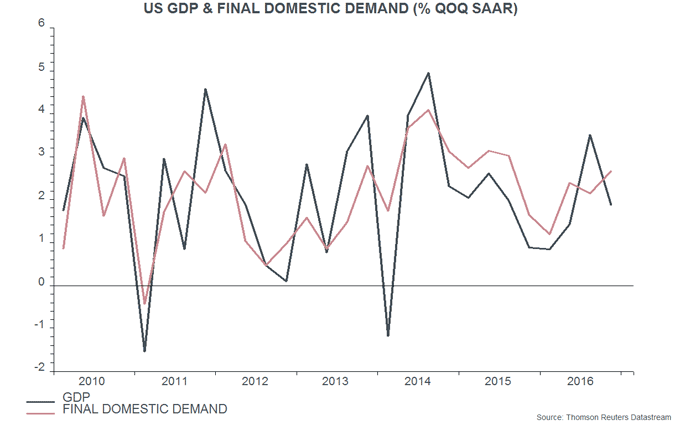
The two-quarter rise in GDP in the fourth quarter was the strongest since the fourth quarter of 2014. As previously discussed, swings in six-month real narrow money expansion have consistently led fluctuations in two-quarter GDP growth in recent years – second chart. GDP acceleration in late 2016 had been predicted by stronger real narrow money growth in late 2015 / early 2016.
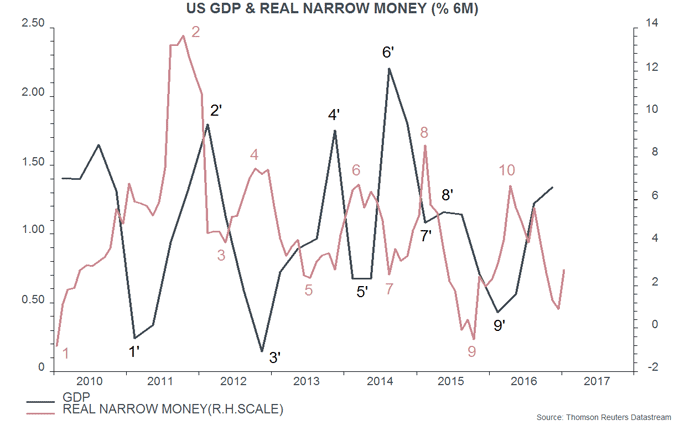
The Federal Reserve last week revised its historical money stock data to incorporate updated seasonal adjustments. According to the revised figures, six-month real narrow money growth peaked in April 2016 – four months earlier than previously reported. Allowing for an average nine-month lead from money to activity, with a normal range of six to 12 months, this suggests that two-quarter GDP growth will peak in the first quarter of 2017, plus or minus one quarter.
Real money growth held up through August 2016 but then fell sharply into December, suggesting an economic slowdown from late spring through September 2017.
Could the economy be seriously weak later in 2017? This is not the central scenario here, for two reasons. First, real money growth appears to have staged a partial recovery in January, based on weekly data through mid-month – the last data point on the second chart is a January estimate.
Secondly, serious economic weakness during the second half would be at odds with the assessment here that the Kitchin stockbuilding and Juglar business investment cycles will remain in upswings throughout 2017.
The Kitchin cycle, usually described as being of between three and five years’ duration, is judged here to have bottomed in mid-2016. The third chart shows an attempt to identify troughs in this cycle over the last 65+ years using two indicators – the Institute for Supply Management manufacturing inventories index and the contribution of stockbuilding to the annual change in GDP. The latter series reached a level consistent with a trough in mid-2016. This date would also fit with the suggested timing of the previous trough in late 2012 – the average interval between troughs over the whole period shown in the chart has been three years and seven months.
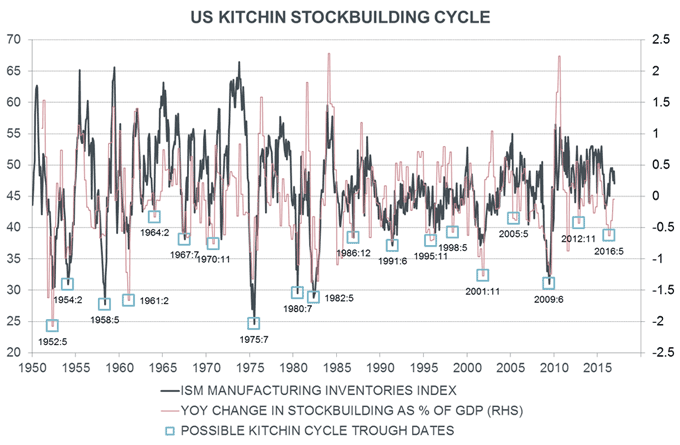
Kitchin cycle upswings usually last for at least 18 months. A mid-2016 trough would imply that the cycle will continue to provide a tailwind to the economy through end-2017.
As an aside, the strength of stock and commodity prices since mid-2016 is consistent with the Kitchin cycle having moved into an upswing. Based on the dates in the chart, the S&P 500 index rose on average by 14.7% percentage points (pp) more in the 18 months following a Kitchin cycle trough than in the prior 18 months. The Journal of Commerce industrial commodity price index rose on average by 20.2 pp more in the post- than pre-trough 18 months.
The Juglar business investment cycle is usually of seven to 11 years’ duration and last bottomed in 2009, implying that another trough is due by 2020. The upswing, however, was interrupted in 2014-15 by the collapse in energy prices and associated profits weakness. With this drag now reversing, a late burst of strength is possible in 2017-18 before the cycle moves into another low.

